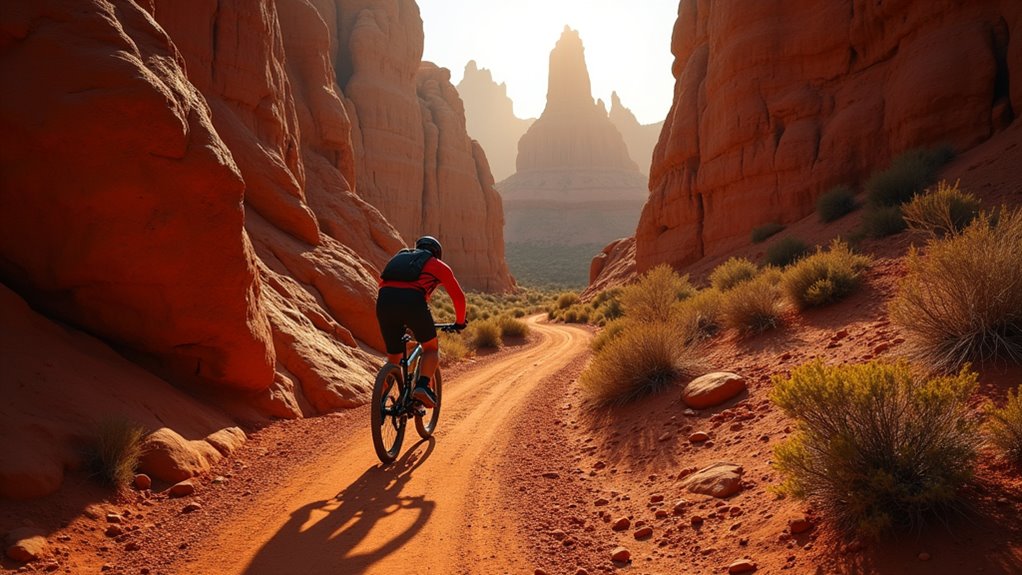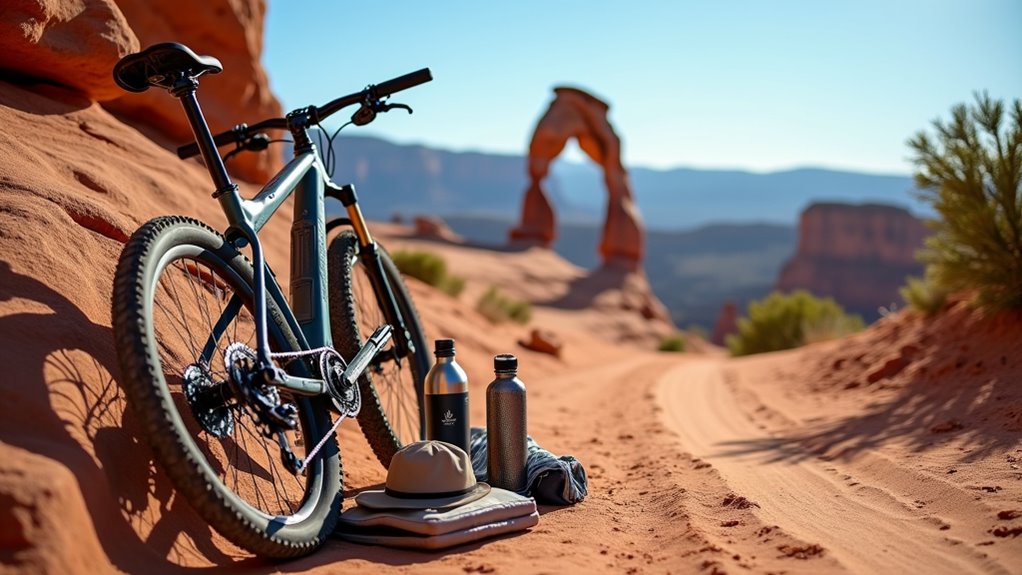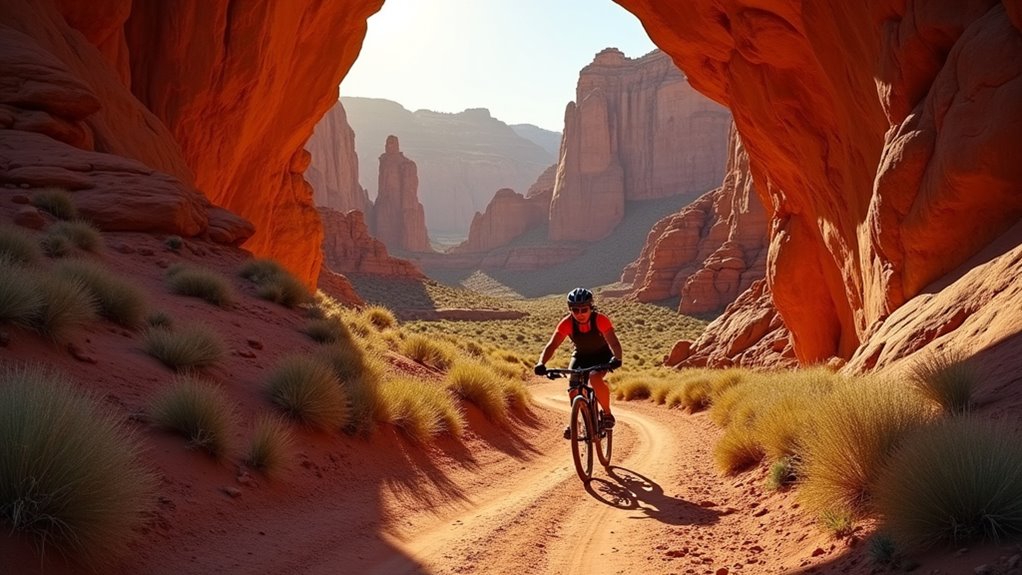Physical Address
304 North Cardinal St.
Dorchester Center, MA 02124
Physical Address
304 North Cardinal St.
Dorchester Center, MA 02124

Wondering which Arches National Park biking trails offer stunning red rock views without requiring expert skills or expensive gear?
You don’t need expensive mountain biking gear to explore Arches National Park’s incredible trails on two wheels. The park’s diverse route options accommodate everyone from casual riders on paved paths to experienced cyclists tackling rugged backcountry terrain. You’ll discover that timing your visit correctly and packing smart essentials can make the difference between an unforgettable adventure and a miserable desert ordeal. Here’s what separates prepared cyclists from those who end up walking their bikes back.

When you’re planning your red rock adventure on a tight budget, Arches National Park offers several bike-friendly routes that won’t cost you extra entrance fees beyond the standard park admission.
The Park Avenue Trail provides stunning views without breaking a sweat – it’s mostly downhill and perfect for beginners. For intermediate riders, tackle the Courthouse Towers section, where you’ll navigate gentle rolling terrain past massive sandstone formations.
Easy downhill rides and rolling terrain make these red rock trails perfect for cyclists of every skill level.
Advanced cyclists should attempt the challenging ride to Delicate Arch Viewpoint, though you’ll need to hike the final stretch. Remember to bring plenty of water since park concessions are pricey.
Start early to avoid crowds and heat, especially during summer months when temperatures soar above 100°F. After your biking adventure, consider setting up camp nearby for additional family camping activities that everyone can enjoy together.
Understanding each trail’s difficulty helps you pick routes that match your fitness level and biking experience. Arches offers three main difficulty categories that’ll save you from costly rescue situations.
Beginner trails feature flat, paved surfaces like Park Avenue Viewpoint. You’ll handle these easily with basic bikes and minimal water supplies.
Intermediate routes include Courthouse Wash, with moderate elevation changes and rocky sections. You’ll need sturdy tires and extra hydration – budget $20 for tire repair kits.
Advanced trails like Salt Valley Road demand serious preparation. Expect loose sand, steep climbs, and remote locations. You’ll require fat-tire bikes, emergency supplies, and GPS devices.
Check weather conditions before heading out. Summer heat creates dangerous riding conditions, while spring and fall offer ideal temperatures for budget-conscious adventurers.
Proper backpack organization ensures you can quickly access essential gear during your ride without dismounting frequently.

Since desert conditions can turn deadly within hours, you’ll need specific gear that protects against heat, dehydration, and mechanical failures. Pack at least one gallon of water per person, plus electrolyte tablets that cost under $10.
A basic repair kit with tire patches, pump, and multi-tool will save you from walking miles in scorching heat.
Wear light-colored, long-sleeved shirts and pants to prevent sunburn while staying cool. A wide-brimmed hat and sunglasses are non-negotiable.
Start early morning rides to avoid peak heat between 10 AM and 4 PM. Tell someone your planned route and return time.
Budget-friendly essentials include a $15 first-aid kit, sunscreen, and energy bars. Your phone might lose signal, so consider downloading offline maps beforehand.
For multi-day desert cycling adventures, consider bringing a compact caravan or camping trailer to establish a comfortable base camp while you embrace the outdoors and explore different trail sections each day.
Proper gear won’t matter much if you pick the wrong time to visit Arches National Park. Desert conditions can make or break your cycling experience, so timing is everything.
Optimal visiting seasons:
Summer’s brutal heat exceeds 100°F, making cycling dangerous and miserable.
You’ll save money visiting during off-peak winter months, but spring and fall offer the sweet spot between comfortable riding conditions and reasonable costs. Consider stress-free camping options during these optimal seasons to enhance your overall Arches National Park experience.

Before you clip into your pedals and start exploring, you’ll need to know which trails actually allow bikes in Arches National Park. You’re restricted to established roads and the park’s designated bike paths – wilderness trails are off-limits.
Stick to paved park roads like the scenic drive to Delicate Arch Viewpoint and Fiery Furnace Road.
You must stay on designated routes and can’t create new paths or shortcuts. Bikes aren’t allowed on any hiking trails, including popular spots like Devil’s Garden Trail.
You’ll need to walk your bike through crowded areas and always yield to pedestrians and vehicles.
Don’t forget your helmet – while not legally required, it’s smart protection.
Park entrance fees apply whether you’re driving or biking, so budget accordingly.
If you’re planning to bring an RV to the park for basecamp camping, research the vehicle restrictions thoroughly to avoid common RV mistakes that could ruin your trip.
You’ll discover that biking Arches doesn’t require expensive gear or guided tours. Sure, the desert terrain might seem intimidating, but start with easier paved routes like Park Avenue before tackling challenging trails. Pack plenty of water, basic repair tools, and stick to designated paths. Time your visit for spring or fall when temperatures won’t drain your energy or wallet on cooling gear. Respect park rules, ride within your limits, and you’ll experience red rock country affordably and safely.